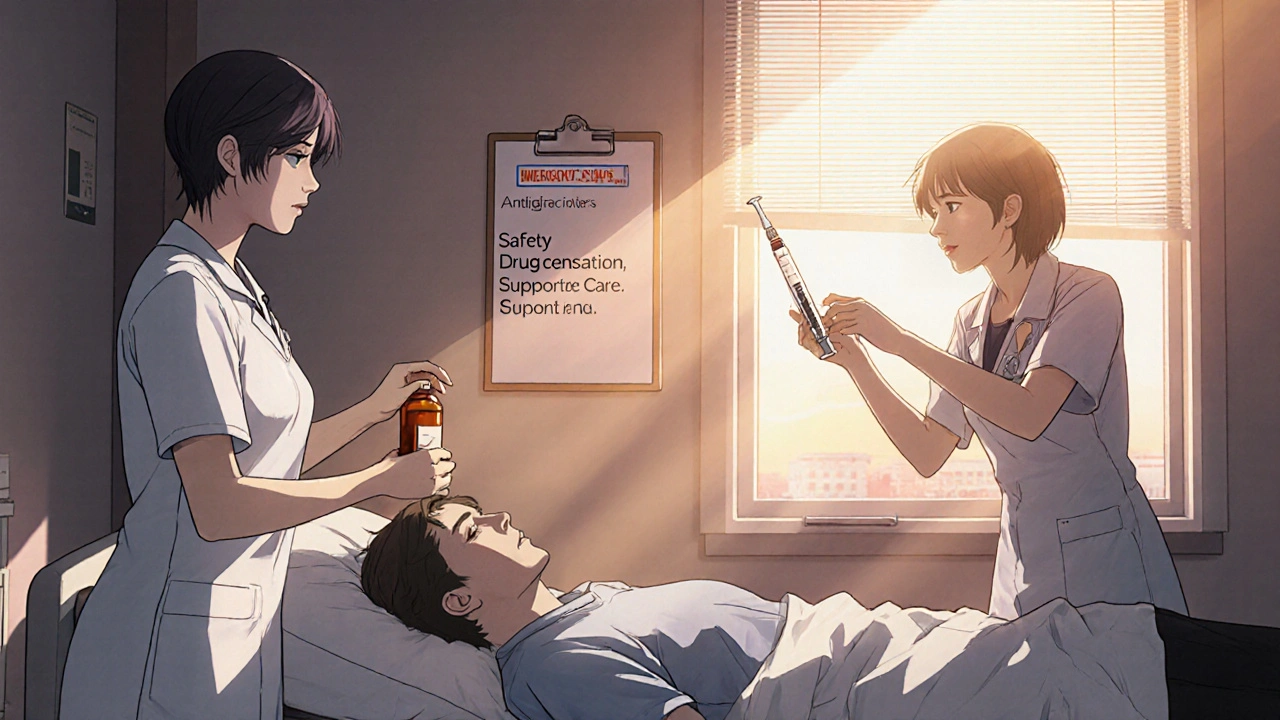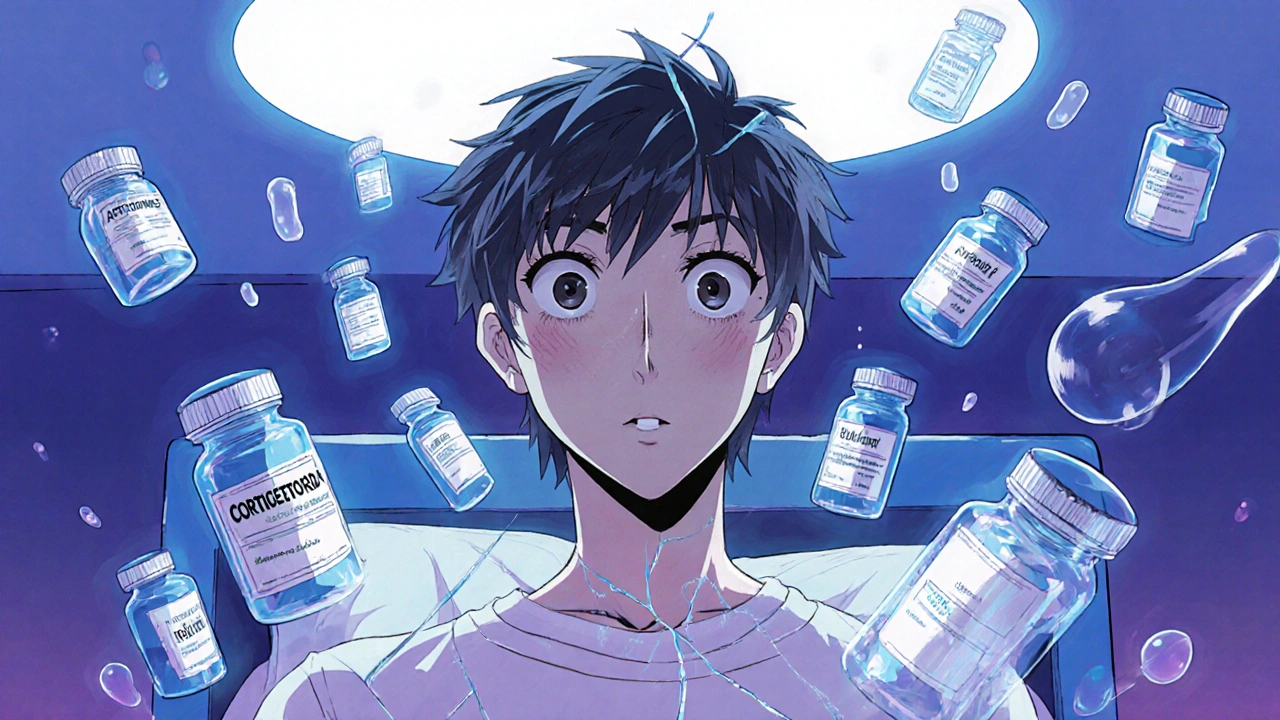Medication-Induced Psychosis Risk Calculator
Medication Risk Assessment
Risk Assessment Results
Risk Level
Onset Timing
Key Symptoms to Watch For
Emergency Steps
When a medication suddenly twists reality, the line between side effects and full‑blown psychosis blurs. Medication‑induced psychosis is a transient disorder marked by delusions, hallucinations, or both that arise directly from a drug’s physiological impact. Recognizing it early can mean the difference between a short hospital stay and a lasting psychiatric condition.
What qualifies as medication‑induced psychosis?
The DSM‑5 sets clear criteria: psychotic symptoms must appear during intoxication or within one month of stopping the drug. They are not better explained by a primary psychotic disorder such as schizophrenia, and they typically resolve once the offending agent is removed. This distinction is crucial-treating a drug‑induced episode as chronic schizophrenia can lock a patient into unnecessary lifelong medication.
Common culprits: drugs that can trigger psychosis
Almost any medication that alters brain chemistry has the potential to cause psychosis, but a handful stand out because of frequency or severity.
- Corticosteroids - high‑dose courses can provoke psychosis in about 5.7% of patients.
- Antimalarial mefloquine - rare but serious, with roughly 1 case per 10,000 courses.
- Antiretroviral efavirenz - neuro‑psychiatric side effects appear in ~2.3% of users.
- Antiepileptic vigabatrin - documented psychosis rate of 1.1%.
- Muscle relaxants (baclofen, cyclobenzaprine), first‑generation antihistamines (diphenhydramine), and certain antidepressants can occasionally induce delusional thoughts.
- Stimulants such as methylphenidate or illicit amphetamines - can cause rapid‑onset paranoia and auditory hallucinations.
- Alcohol or benzodiazepine withdrawal - severe withdrawal can mimic a psychotic break.
| Drug Class | Typical Onset | Incidence of Psychosis |
|---|---|---|
| Corticosteroids | Days to weeks of high‑dose therapy | ≈5.7% |
| Antimalarials (mefloquine) | Within 1-2 weeks of start | ≈0.01% |
| Antiretrovirals (efavirenz) | First few weeks | ≈2.3% |
| Stimulants (cocaine, meth) | Minutes to hours | 90‑96% for cocaine users |
| Withdrawal (alcohol, benzodiazepines) | Days to weeks after cessation | Varies; severe cases often lead to delirium tremens |
Spotting the symptoms
Even though each drug has its own signature, the core psychotic features overlap.
- Delusions - fixed false beliefs such as paranoia that someone is out to harm you.
- Hallucinations - seeing, hearing, or feeling things that aren’t there; auditory voices are the most common.
- Disorganized speech or incoherent thoughts.
- Impaired concentration, memory lapses, and poor executive function.
- Behavior that seems out of place - agitation, aggression, or extreme withdrawal.
Persecutory delusions and auditory hallucinations dominate across most medication classes, according to a 2022 PubMed review. Mood swings or anxiety often precede full‑blown psychosis, especially with steroids or antimalarials, offering a valuable prodromal warning window.
Who is most at risk?
Risk isn’t random. Several factors increase susceptibility:
- Previous psychiatric history - especially schizophrenia spectrum disorders.
- Female sex - shown to carry higher odds for many drug‑induced episodes.
- Concurrent substance use disorder - compounds the neurochemical insult.
- High cumulative dose or rapid titration of the offending drug.
- Genetic predispositions - emerging research points to specific gene variants that may predict vulnerability.
Because of these overlaps, clinicians must sift through the patient’s full medication list, including over‑the‑counter products, before labeling an episode as primary psychosis.
Emergency management: a step‑by‑step plan
When a patient presents with sudden delusions or hallucinations, time is critical. Below is a practical emergency pathway.
- Emergency Management - ensure safety first. Remove weapons, secure the environment, and involve security if needed.
- Obtain a rapid medication history. Ask about any new prescriptions, dose changes, or over‑the‑counter use within the past month.
- Discontinue the suspected drug immediately. If the medication is a life‑saving agent (e.g., antiretrovirals), coordinate with the prescribing specialist before abrupt stop.
- Supportive care: intravenous fluids, electrolyte monitoring, and temperature regulation. In stimulant‑related cases, watch for rhabdomyolysis.
- Consider short‑term antipsychotics for severe agitation or risk of self‑harm. Atypical agents like olanzapine or quetiapine are common, but clinicians must check for drug‑drug interactions.
- For withdrawal‑triggered psychosis (alcohol, benzodiazepines), initiate a controlled benzodiazepine taper under supervision to avoid delirium tremens.
- Continuous observation for at least 24‑48 hours, longer if symptoms linger beyond the drug’s half‑life.
- Document the episode thoroughly - include drug name, dose, onset timing, and symptom resolution timeline.
If the patient poses an imminent danger to themselves or others, involuntary admission under mental‑health legislation may be required.

Prognosis and follow‑up
Most drug‑induced episodes resolve within weeks once the culprit is removed. Steroid‑related psychosis typically clears in 4-6 weeks, while cocaine‑induced forms may subside in 1-3 days. However, prolonged exposure or high‑dose regimens can leave lingering deficits, necessitating ongoing psychiatric care.
Guidelines advise a minimum three‑month follow‑up to watch for emerging primary psychotic disorders. If symptoms persist beyond one month after cessation, clinicians should reconsider the diagnosis and possibly start long‑term antipsychotic therapy.
Prevention: what clinicians and patients can do
Prevention hinges on vigilance:
- Before starting high‑risk drugs (e.g., corticosteroids), screen for personal or family psychiatric history.
- Educate patients about early warning signs - mood swings, anxiety, sleep disturbances.
- Use the lowest effective dose and taper gradually whenever possible.
- Implement regular medication reviews, especially when patients are on polypharmacy regimes.
- Encourage patients to report new mental‑health symptoms immediately - many drug guides now contain FDA‑mandated alerts.
Future research hopes to integrate genetic testing into prescribing workflows, allowing clinicians to flag high‑risk individuals before a prescription is written.
Key Takeaways
- Medication‑induced psychosis is a reversible condition that appears during or shortly after drug exposure.
- Typical triggers include high‑dose corticosteroids, antimalarials (mefloquine), antiretrovirals (efavirenz), and stimulant drugs.
- Core symptoms: delusions, hallucinations, disorganized thought, and risky behavior.
- Emergency care centers on safety, immediate drug cessation, supportive measures, and short‑term antipsychotics when needed.
- Most cases resolve within weeks, but a structured follow‑up is essential to rule out lasting psychiatric illness.
How quickly do symptoms appear after taking a risky medication?
Onset varies by drug. Stimulants like cocaine can cause psychosis within minutes, while corticosteroid‑related symptoms often emerge after several days of high‑dose therapy. Generally, symptoms appear within the first month of exposure.
Can medication‑induced psychosis be permanent?
It is usually transient. When the offending drug is stopped promptly, most patients recover fully within weeks. Persistent symptoms beyond one month may signal an underlying primary psychotic disorder, requiring further evaluation.
What are the safest antipsychotics to use in an emergency?
Atypical agents such as olanzapine or quetiapine are commonly chosen because they have a lower risk of extrapyramidal side effects. However, clinicians must consider potential interactions with the precipitating medication.
Should family members contact emergency services if they suspect drug‑induced psychosis?
Yes. Immediate medical evaluation is crucial, especially if the person is a danger to themselves or others. Early intervention speeds up drug discontinuation and reduces complications.
Are over‑the‑counter meds capable of causing psychosis?
First‑generation antihistamines like diphenhydramine and high‑dose ibuprofen have rare reports of psychotic reactions, especially when misused or combined with other CNS‑active substances.


4 Comments
Edward BrownOctober 25, 2025 AT 18:42
We live in a world where the pills we trust are often engineered to pull the strings behind our perception. The subtle chemistry that flips reality is not an accident but a calculated tool for control. When a corticosteroid whispers “trust me” and then shouts delusions, you have to wonder who benefits from that chaos. Most clinicians see a symptom, not the systematic manipulation baked into the drug pipeline. The fact that the DSM definition is so tidy only masks the messy truth of corporate influence. Stay vigilant and question every prescription.
ALBERT HENDERSHOT JR.November 7, 2025 AT 10:20
Thanks for highlighting those concerns, Edward. It’s true that medication‑induced psychosis can feel alarming, but early recognition and a structured emergency plan often prevent long‑term sequelae. Clinicians should prioritize a thorough medication history, including over‑the‑counter agents, and consider a gradual taper when feasible.
When done correctly, patients usually recover within weeks, and the risk of permanent impairment is low. 😊
Suzanne CarawanNovember 20, 2025 AT 03:53
Oh great, another cautionary tale about “dangerous” pills. As if everyone reads the fine print before popping steroids. The real problem is that we love drama more than data, so we’ll keep shouting about rare side effects forever. Good luck finding a pharmacy that hands out paranoia with their prescriptions.
Kala RaniDecember 2, 2025 AT 21:26
Sure Suzanne the panic is overblown but ignore the stats and you miss real cases where life is ruined. Even a .01% rate matters when millions take the drug. Under‑reporting is a thing too.